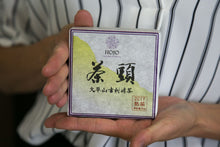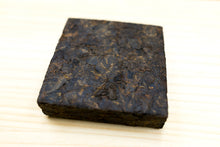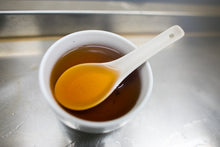This tea offers a soft, mellow, and rich drinking experience, accompanied by a herbal aroma reminiscent of camphor and dried fruit flavors similar to Chinese dates or raisins. Based on my experience, this tea will improve even further if you manage to age it longer.
A Rare Tea
Cha Tou is quite rare, even within the domestic Chinese tea market. It consists of lumps of ripe pu-erh tea that naturally form during the microbiological fermentation process. These tea lumps are created only when spring tea is processed into ripe pu-erh. In contrast, summer and autumn teas tend to have lower moisture levels and fewer tea constituents, making the likelihood of finding Cha Tou in those varieties quite low. Ripe pu-erh tea made from spring leaves is thus very rare, and Cha Tou is highly sought after by tea connoisseurs.
When the fermentation of ripe pu-erh tea is executed well, the tea lumps are formed naturally due to the polysaccharides produced by Actinomycetes. During the formation of Cha Tou, the tea leaves become trapped inside the lump in an oxygen-free environment. The fermentation process also raises the temperature to about 70 degrees Celsius, which accelerates the maturation of the tea leaves trapped within the Cha Tou, resulting in a unique flavor profile.
Cha Tou Made from Huo Cao Shan Ripe Pu-erh Tea
Huo Cao Shan Cha Tou is formed during the production of Huo Cao Shan Ripe Pu-erh Tea, one of the most popular ripe pu-erh teas in HOJO’s lineup. Those who have tried this tea may be surprised by its distinctive taste profile. In fact, it delivers a drinking experience similar to high-grade raw pu-erh tea, offering an incredibly soft and long-lasting flavor that truly evokes the characteristics of raw pu-erh. I also recommend Huo Cao Shan Ripe Pu-erh Tea for those who enjoy raw pu-erh but may not often drink ripe pu-erh.
It is quite rare for high-quality raw pu-erh tea to be used as the base tea for making ripe pu-erh tea. This is primarily because high-quality raw pu-erh comes at a significantly higher cost, while consumers typically perceive ripe pu-erh tea as a lower-priced option. Therefore, it is uncommon for ripe pu-erh tea to be made from high-quality spring tea. For more information about Huo Cao Shan Ripe Pu-erh tea, please refer to the following article:
https://hojotea.com/en/posts-197/
Very Well-Aged Cha Tou Produces Flavors Similar to Brandy
When aged, Cha Tou develops a remarkably unique flavor. In my experience, it often gains sudden popularity in my shop after being stored for more than a year or two. To age it well, keep it in a warmer area of your home. After opening the bag, be sure to zip it back up and let it sit for about one to two weeks before you start drinking it. This process is known as “decanting” the tea. During this time, the tea will gently oxidize, swiftly developing fruity notes and a richer taste—much like decanting wine.
Brewing Method for Cha Tou
Cha Tou is denser than regular ripe pu-erh tea, so it requires a longer steeping time to fully extract its flavors. Begin by pouring boiling water into the teapot and allowing it to sit for about 10 seconds to warm the pot. After discarding the hot water, add 5 to 10 grams of Cha Tou, then pour in boiling water and let it steep for 10 seconds before discarding. Repeat this step by adding more boiling water and steeping for another 10 seconds before discarding again.
For the first infusion, pour boiling water over the tea and let it steep for 30 seconds to 1 minute. For the second infusion, you can repeat this process for a stronger flavor, or adjust the steeping time to suit your taste. For subsequent brews, if you prefer a lighter flavor, steep for 10 seconds or less. Conversely, if you want a richer taste, you can extend the steeping time.
In general, Cha Tou can be steeped 6 times or more.









